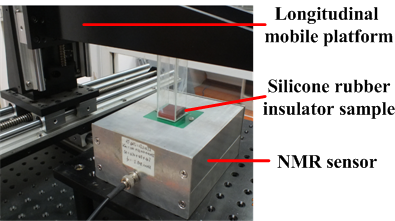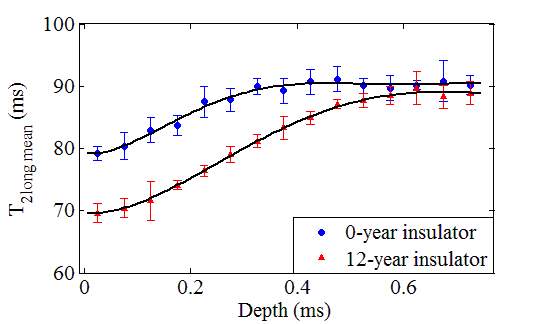Unilateral NMR method for assessing the aging status of silicone rubber insulator
- 1. Chongqing University, Chongqing, China
- 2. Chongqing Normal University, Chongqing, China
Introduction:
The aging of silicone rubber insulators threatens the safety of the power grid. An accurate estimation of their aging status is necessary for taking precautions against insulation failure. In this study, an unilateral NMR method was employed for 1D depth profile measurements to explore the aging level along the depth of the insulator.
Hardware:
The unilateral NMR sensor is consisted of three parts: magnet, RF coil, and tuning and marching circuit. The sensor is shown in Fig1. The whole sensor has a size of 68mm×129mm×154mm. Its magnet is composed of 2 iron sheets and 5 magnet blocks. The magnetic field is homogeneous in a horizontal slice (338ppm) at 1.9mm above the sensor, and a constant gradient (4.6T/m) is built along the vertical direction. The strength of B0 field in the centre of the slice is 136.3mT.

Experimental details:
Two silicone rubber insulators with different service times of 0 year (new insulator) and 12 years in the same power line were measured. By varying the distance between the sensor and the sample through a longitudinal mobile platform, fifteen 50 micrometer thick layers from the insulators' surface to 0.75 mm penetration depth were measured on each sample. The CPMG sequence was employed to record the 1H transverse relaxation decay curves. The curves were performed with the inverse Laplace transformation for one dimensional T2 distribution analysis.
Results:
Fig.2 demonstrates that the aging results in a decrease in the NMR transverse relaxation time, and more serious aging results in a more severe decrease. Furthermore, the long T2 component increases from the surface of the insulator to the inner layer. And a longer service time results in a more rapid increase in long T2 component.

Conclusion:
A novel unilateral NMR method was employed for 1D depth profile measurements to explore the aging level distribution along the depth of silicone rubber insulators. It shows that the long T2 component values on each layers can reflect the aging distribution of the silicone rubber insulator. The result of this experiment may be used to predict the service life of composite insulators.
- [1] Zheng Xu, Kaikai Meng, Jiangyan Cheng, (2015), Highly uniform single-sided portable NMR sensor and its application in assessing the aging level of silicone rubber insulator, International Journal of Applied Electromagnetics Mechanics, 777-790
- [2] Zheng Xu, Shujie Zhao, Pan Guo, (2013), A portable NMR sensor used for assessing the aging status of silicone rubber insulator, Applied Magnetic Resonance, 1405-1417
